Healthcare Management Research Proposal: PCNs, Pain or Panacea?
VerifiedAdded on 2022/08/08
|15
|3680
|29
Report
AI Summary
This research proposal investigates the effectiveness of Patient Care Networks (PCNs) within the UK healthcare system. It begins with an introduction to PCNs, their role in the NHS, and the problem statement highlighting the need for further analysis of their impact. The rationale emphasizes the increasing demand for healthcare services and the importance of efficient delivery. The research aims to evaluate the benefits of PCNs, examining their role in delivering quality care and identifying areas for improvement. The literature review explores the concept of PCNs, the role of pharmacists within these networks, and the framework of primary care, emphasizing the shift towards patient-centered approaches and accessible services. The methodology outlines the research study, search strategy, and data analysis methods. The proposal also includes a timeline and a summary of the study's objectives and expected outcomes, aiming to provide insights into the future of healthcare delivery through PCNs.

Running head: HEALTHCARE MANAGEMENT
PCNs: PAIN OR PANACEA?
Name of the Student:
Name of the University:
Author Note:
PCNs: PAIN OR PANACEA?
Name of the Student:
Name of the University:
Author Note:
Paraphrase This Document
Need a fresh take? Get an instant paraphrase of this document with our AI Paraphraser
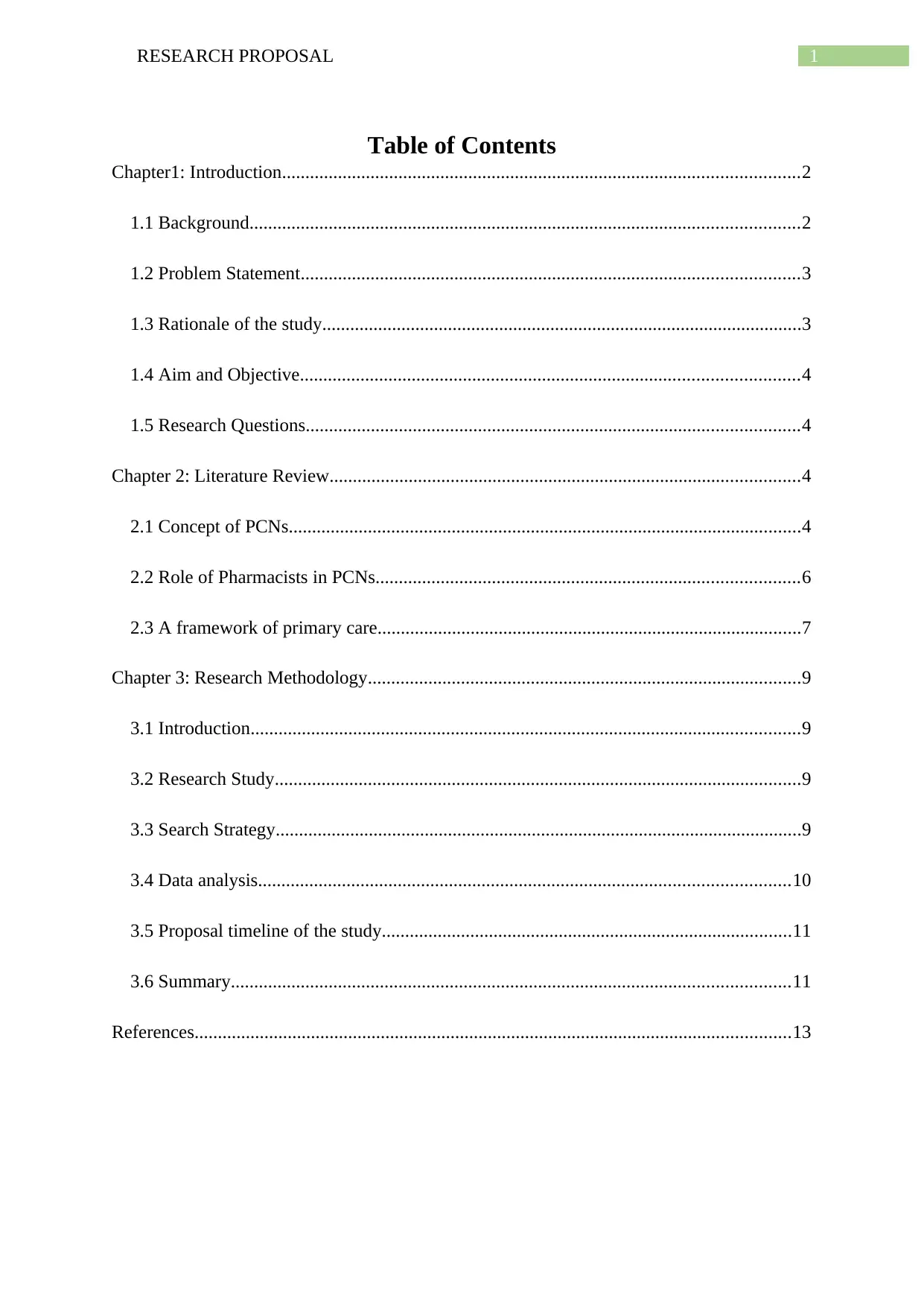
1RESEARCH PROPOSAL
Table of Contents
Chapter1: Introduction...............................................................................................................2
1.1 Background......................................................................................................................2
1.2 Problem Statement...........................................................................................................3
1.3 Rationale of the study.......................................................................................................3
1.4 Aim and Objective...........................................................................................................4
1.5 Research Questions..........................................................................................................4
Chapter 2: Literature Review.....................................................................................................4
2.1 Concept of PCNs..............................................................................................................4
2.2 Role of Pharmacists in PCNs...........................................................................................6
2.3 A framework of primary care...........................................................................................7
Chapter 3: Research Methodology.............................................................................................9
3.1 Introduction......................................................................................................................9
3.2 Research Study.................................................................................................................9
3.3 Search Strategy.................................................................................................................9
3.4 Data analysis..................................................................................................................10
3.5 Proposal timeline of the study........................................................................................11
3.6 Summary........................................................................................................................11
References................................................................................................................................13
Table of Contents
Chapter1: Introduction...............................................................................................................2
1.1 Background......................................................................................................................2
1.2 Problem Statement...........................................................................................................3
1.3 Rationale of the study.......................................................................................................3
1.4 Aim and Objective...........................................................................................................4
1.5 Research Questions..........................................................................................................4
Chapter 2: Literature Review.....................................................................................................4
2.1 Concept of PCNs..............................................................................................................4
2.2 Role of Pharmacists in PCNs...........................................................................................6
2.3 A framework of primary care...........................................................................................7
Chapter 3: Research Methodology.............................................................................................9
3.1 Introduction......................................................................................................................9
3.2 Research Study.................................................................................................................9
3.3 Search Strategy.................................................................................................................9
3.4 Data analysis..................................................................................................................10
3.5 Proposal timeline of the study........................................................................................11
3.6 Summary........................................................................................................................11
References................................................................................................................................13
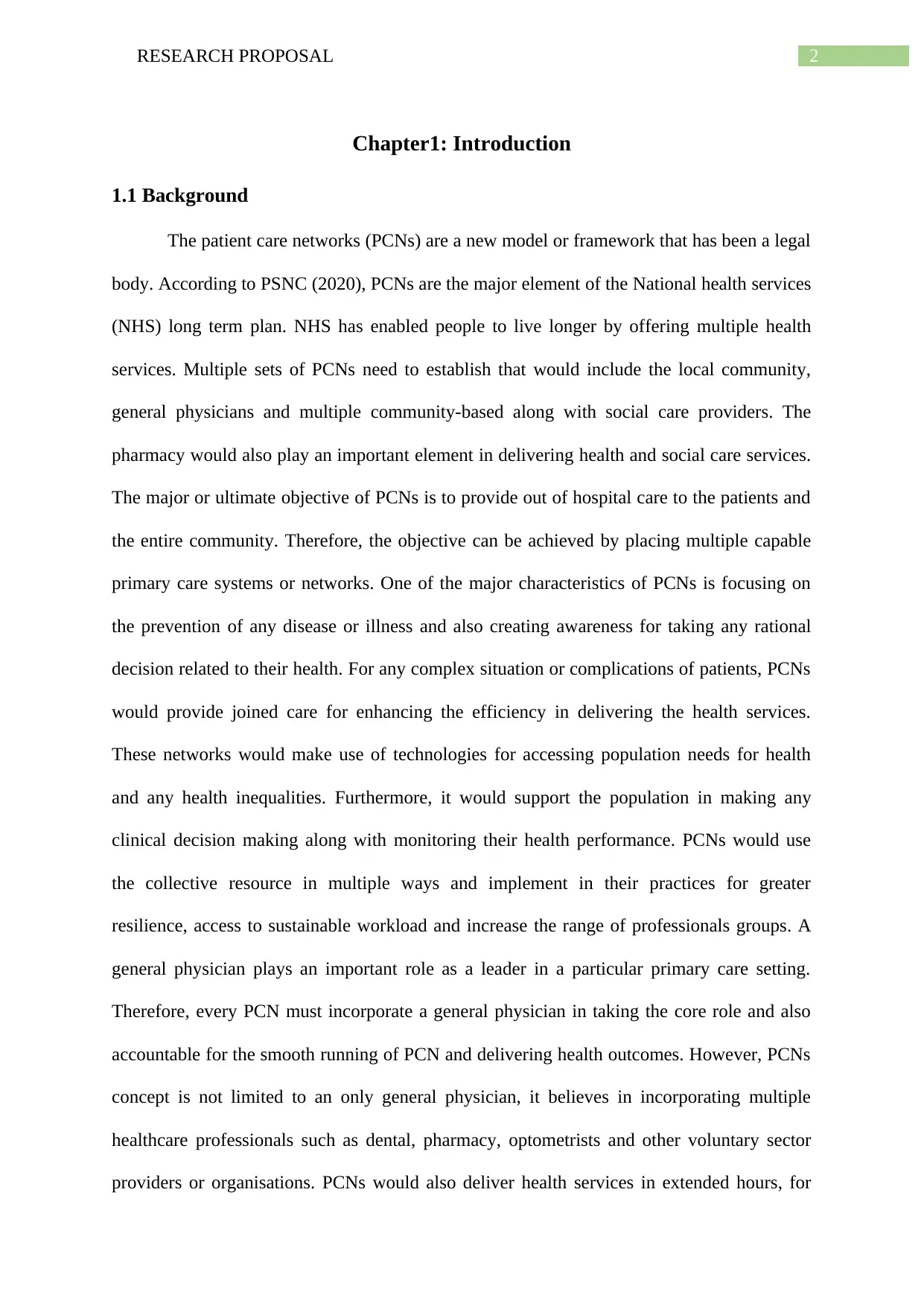
2RESEARCH PROPOSAL
Chapter1: Introduction
1.1 Background
The patient care networks (PCNs) are a new model or framework that has been a legal
body. According to PSNC (2020), PCNs are the major element of the National health services
(NHS) long term plan. NHS has enabled people to live longer by offering multiple health
services. Multiple sets of PCNs need to establish that would include the local community,
general physicians and multiple community-based along with social care providers. The
pharmacy would also play an important element in delivering health and social care services.
The major or ultimate objective of PCNs is to provide out of hospital care to the patients and
the entire community. Therefore, the objective can be achieved by placing multiple capable
primary care systems or networks. One of the major characteristics of PCNs is focusing on
the prevention of any disease or illness and also creating awareness for taking any rational
decision related to their health. For any complex situation or complications of patients, PCNs
would provide joined care for enhancing the efficiency in delivering the health services.
These networks would make use of technologies for accessing population needs for health
and any health inequalities. Furthermore, it would support the population in making any
clinical decision making along with monitoring their health performance. PCNs would use
the collective resource in multiple ways and implement in their practices for greater
resilience, access to sustainable workload and increase the range of professionals groups. A
general physician plays an important role as a leader in a particular primary care setting.
Therefore, every PCN must incorporate a general physician in taking the core role and also
accountable for the smooth running of PCN and delivering health outcomes. However, PCNs
concept is not limited to an only general physician, it believes in incorporating multiple
healthcare professionals such as dental, pharmacy, optometrists and other voluntary sector
providers or organisations. PCNs would also deliver health services in extended hours, for
Chapter1: Introduction
1.1 Background
The patient care networks (PCNs) are a new model or framework that has been a legal
body. According to PSNC (2020), PCNs are the major element of the National health services
(NHS) long term plan. NHS has enabled people to live longer by offering multiple health
services. Multiple sets of PCNs need to establish that would include the local community,
general physicians and multiple community-based along with social care providers. The
pharmacy would also play an important element in delivering health and social care services.
The major or ultimate objective of PCNs is to provide out of hospital care to the patients and
the entire community. Therefore, the objective can be achieved by placing multiple capable
primary care systems or networks. One of the major characteristics of PCNs is focusing on
the prevention of any disease or illness and also creating awareness for taking any rational
decision related to their health. For any complex situation or complications of patients, PCNs
would provide joined care for enhancing the efficiency in delivering the health services.
These networks would make use of technologies for accessing population needs for health
and any health inequalities. Furthermore, it would support the population in making any
clinical decision making along with monitoring their health performance. PCNs would use
the collective resource in multiple ways and implement in their practices for greater
resilience, access to sustainable workload and increase the range of professionals groups. A
general physician plays an important role as a leader in a particular primary care setting.
Therefore, every PCN must incorporate a general physician in taking the core role and also
accountable for the smooth running of PCN and delivering health outcomes. However, PCNs
concept is not limited to an only general physician, it believes in incorporating multiple
healthcare professionals such as dental, pharmacy, optometrists and other voluntary sector
providers or organisations. PCNs would also deliver health services in extended hours, for
⊘ This is a preview!⊘
Do you want full access?
Subscribe today to unlock all pages.

Trusted by 1+ million students worldwide
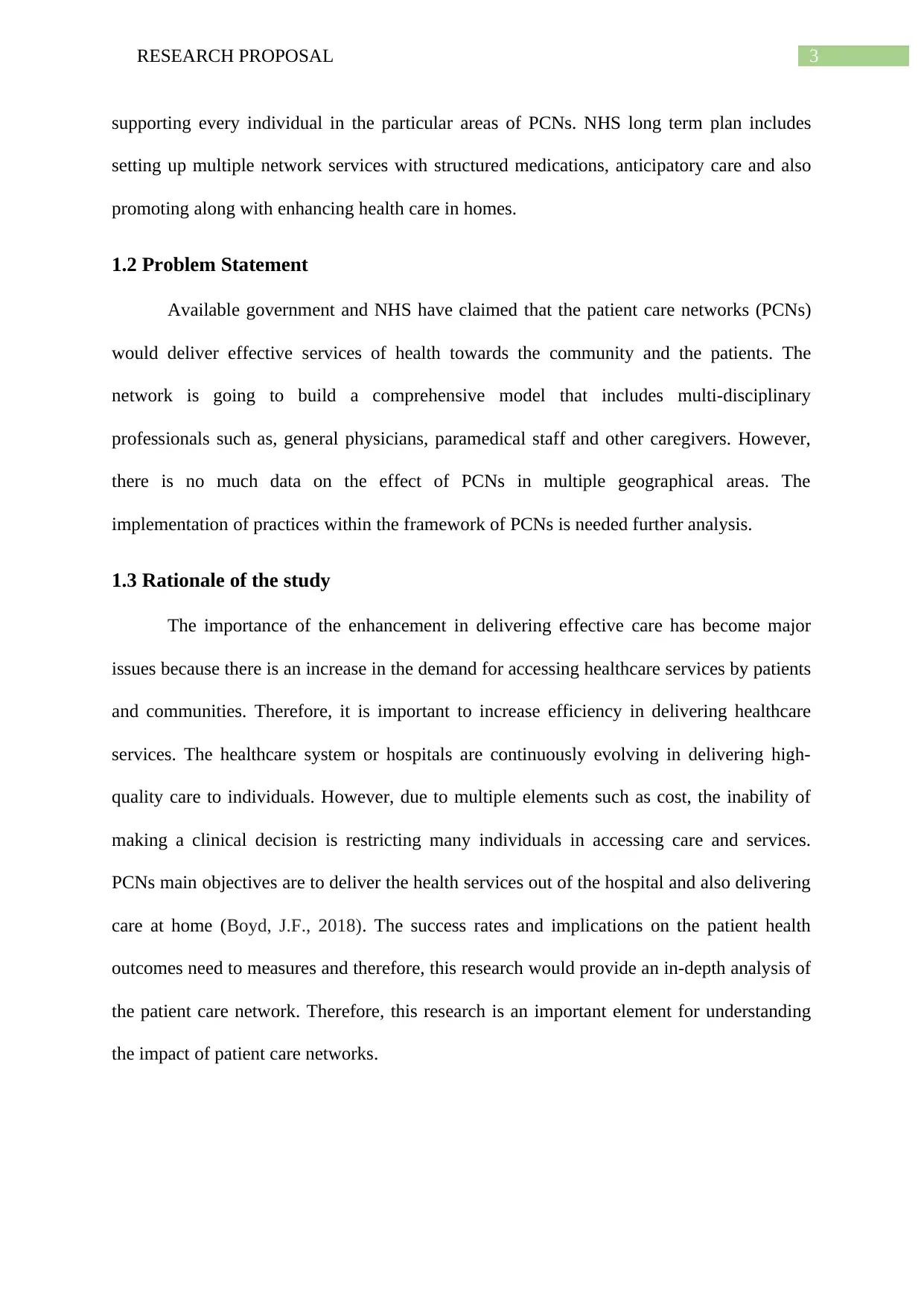
3RESEARCH PROPOSAL
supporting every individual in the particular areas of PCNs. NHS long term plan includes
setting up multiple network services with structured medications, anticipatory care and also
promoting along with enhancing health care in homes.
1.2 Problem Statement
Available government and NHS have claimed that the patient care networks (PCNs)
would deliver effective services of health towards the community and the patients. The
network is going to build a comprehensive model that includes multi-disciplinary
professionals such as, general physicians, paramedical staff and other caregivers. However,
there is no much data on the effect of PCNs in multiple geographical areas. The
implementation of practices within the framework of PCNs is needed further analysis.
1.3 Rationale of the study
The importance of the enhancement in delivering effective care has become major
issues because there is an increase in the demand for accessing healthcare services by patients
and communities. Therefore, it is important to increase efficiency in delivering healthcare
services. The healthcare system or hospitals are continuously evolving in delivering high-
quality care to individuals. However, due to multiple elements such as cost, the inability of
making a clinical decision is restricting many individuals in accessing care and services.
PCNs main objectives are to deliver the health services out of the hospital and also delivering
care at home (Boyd, J.F., 2018). The success rates and implications on the patient health
outcomes need to measures and therefore, this research would provide an in-depth analysis of
the patient care network. Therefore, this research is an important element for understanding
the impact of patient care networks.
supporting every individual in the particular areas of PCNs. NHS long term plan includes
setting up multiple network services with structured medications, anticipatory care and also
promoting along with enhancing health care in homes.
1.2 Problem Statement
Available government and NHS have claimed that the patient care networks (PCNs)
would deliver effective services of health towards the community and the patients. The
network is going to build a comprehensive model that includes multi-disciplinary
professionals such as, general physicians, paramedical staff and other caregivers. However,
there is no much data on the effect of PCNs in multiple geographical areas. The
implementation of practices within the framework of PCNs is needed further analysis.
1.3 Rationale of the study
The importance of the enhancement in delivering effective care has become major
issues because there is an increase in the demand for accessing healthcare services by patients
and communities. Therefore, it is important to increase efficiency in delivering healthcare
services. The healthcare system or hospitals are continuously evolving in delivering high-
quality care to individuals. However, due to multiple elements such as cost, the inability of
making a clinical decision is restricting many individuals in accessing care and services.
PCNs main objectives are to deliver the health services out of the hospital and also delivering
care at home (Boyd, J.F., 2018). The success rates and implications on the patient health
outcomes need to measures and therefore, this research would provide an in-depth analysis of
the patient care network. Therefore, this research is an important element for understanding
the impact of patient care networks.
Paraphrase This Document
Need a fresh take? Get an instant paraphrase of this document with our AI Paraphraser
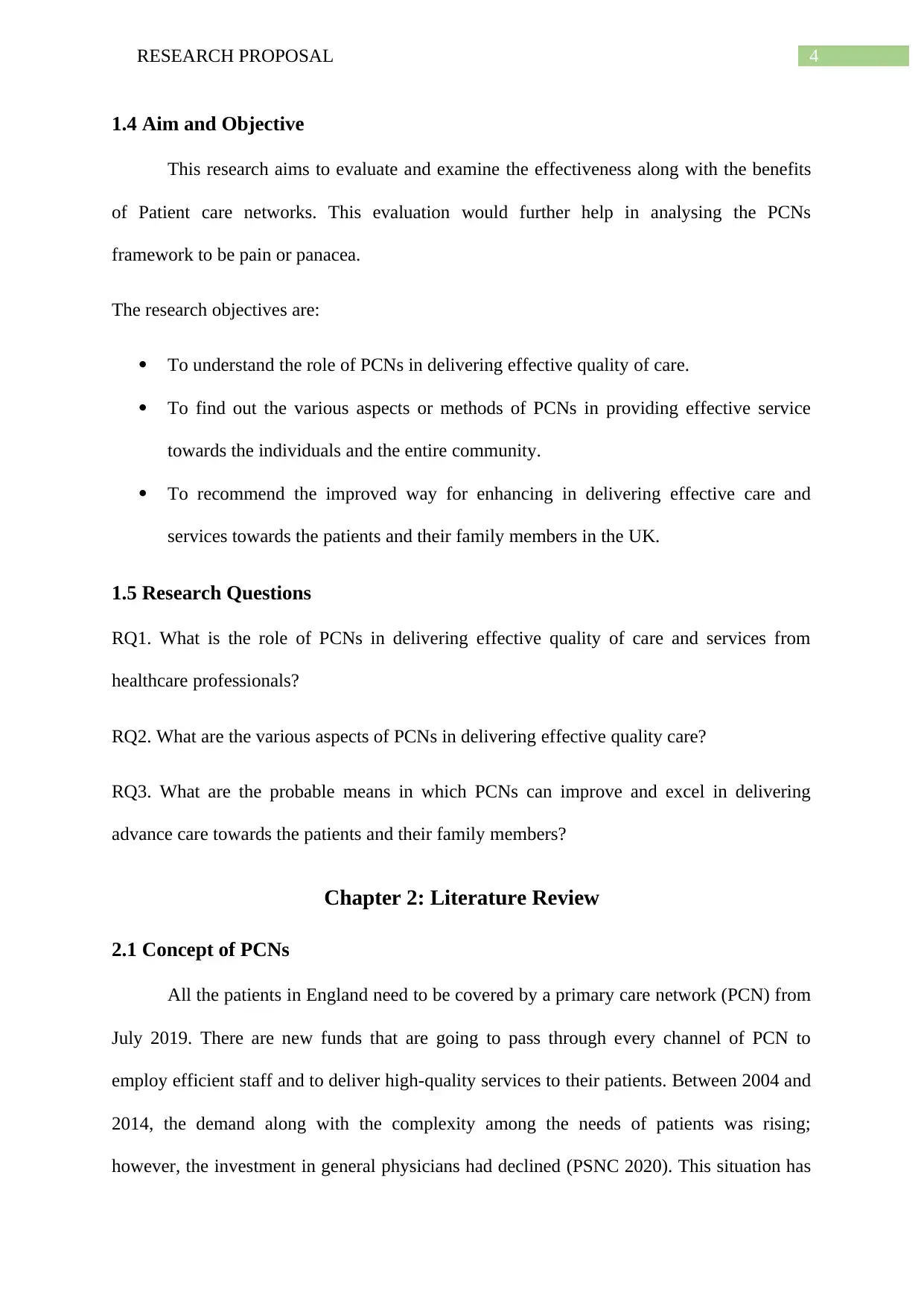
4RESEARCH PROPOSAL
1.4 Aim and Objective
This research aims to evaluate and examine the effectiveness along with the benefits
of Patient care networks. This evaluation would further help in analysing the PCNs
framework to be pain or panacea.
The research objectives are:
To understand the role of PCNs in delivering effective quality of care.
To find out the various aspects or methods of PCNs in providing effective service
towards the individuals and the entire community.
To recommend the improved way for enhancing in delivering effective care and
services towards the patients and their family members in the UK.
1.5 Research Questions
RQ1. What is the role of PCNs in delivering effective quality of care and services from
healthcare professionals?
RQ2. What are the various aspects of PCNs in delivering effective quality care?
RQ3. What are the probable means in which PCNs can improve and excel in delivering
advance care towards the patients and their family members?
Chapter 2: Literature Review
2.1 Concept of PCNs
All the patients in England need to be covered by a primary care network (PCN) from
July 2019. There are new funds that are going to pass through every channel of PCN to
employ efficient staff and to deliver high-quality services to their patients. Between 2004 and
2014, the demand along with the complexity among the needs of patients was rising;
however, the investment in general physicians had declined (PSNC 2020). This situation has
1.4 Aim and Objective
This research aims to evaluate and examine the effectiveness along with the benefits
of Patient care networks. This evaluation would further help in analysing the PCNs
framework to be pain or panacea.
The research objectives are:
To understand the role of PCNs in delivering effective quality of care.
To find out the various aspects or methods of PCNs in providing effective service
towards the individuals and the entire community.
To recommend the improved way for enhancing in delivering effective care and
services towards the patients and their family members in the UK.
1.5 Research Questions
RQ1. What is the role of PCNs in delivering effective quality of care and services from
healthcare professionals?
RQ2. What are the various aspects of PCNs in delivering effective quality care?
RQ3. What are the probable means in which PCNs can improve and excel in delivering
advance care towards the patients and their family members?
Chapter 2: Literature Review
2.1 Concept of PCNs
All the patients in England need to be covered by a primary care network (PCN) from
July 2019. There are new funds that are going to pass through every channel of PCN to
employ efficient staff and to deliver high-quality services to their patients. Between 2004 and
2014, the demand along with the complexity among the needs of patients was rising;
however, the investment in general physicians had declined (PSNC 2020). This situation has
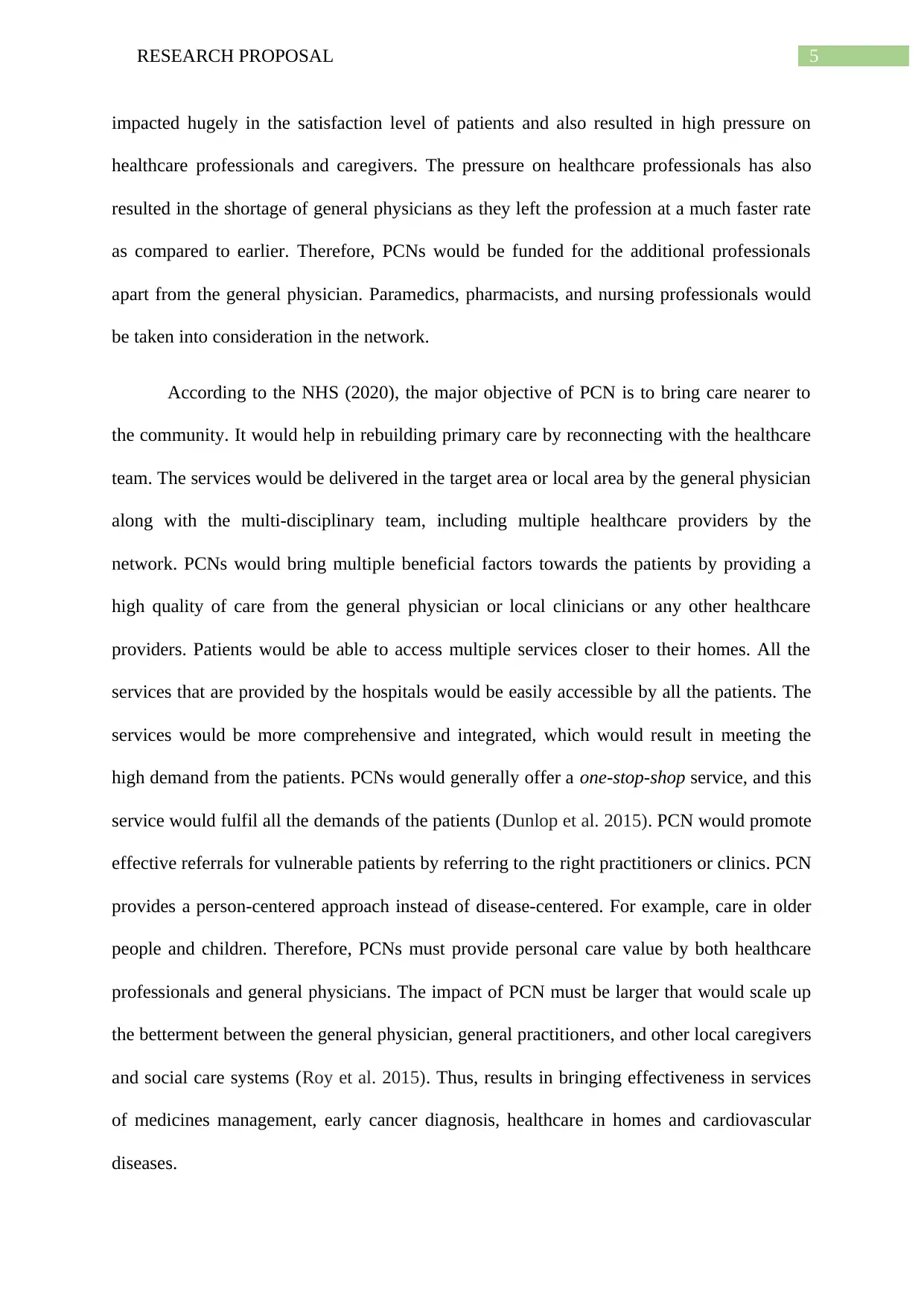
5RESEARCH PROPOSAL
impacted hugely in the satisfaction level of patients and also resulted in high pressure on
healthcare professionals and caregivers. The pressure on healthcare professionals has also
resulted in the shortage of general physicians as they left the profession at a much faster rate
as compared to earlier. Therefore, PCNs would be funded for the additional professionals
apart from the general physician. Paramedics, pharmacists, and nursing professionals would
be taken into consideration in the network.
According to the NHS (2020), the major objective of PCN is to bring care nearer to
the community. It would help in rebuilding primary care by reconnecting with the healthcare
team. The services would be delivered in the target area or local area by the general physician
along with the multi-disciplinary team, including multiple healthcare providers by the
network. PCNs would bring multiple beneficial factors towards the patients by providing a
high quality of care from the general physician or local clinicians or any other healthcare
providers. Patients would be able to access multiple services closer to their homes. All the
services that are provided by the hospitals would be easily accessible by all the patients. The
services would be more comprehensive and integrated, which would result in meeting the
high demand from the patients. PCNs would generally offer a one-stop-shop service, and this
service would fulfil all the demands of the patients (Dunlop et al. 2015). PCN would promote
effective referrals for vulnerable patients by referring to the right practitioners or clinics. PCN
provides a person-centered approach instead of disease-centered. For example, care in older
people and children. Therefore, PCNs must provide personal care value by both healthcare
professionals and general physicians. The impact of PCN must be larger that would scale up
the betterment between the general physician, general practitioners, and other local caregivers
and social care systems (Roy et al. 2015). Thus, results in bringing effectiveness in services
of medicines management, early cancer diagnosis, healthcare in homes and cardiovascular
diseases.
impacted hugely in the satisfaction level of patients and also resulted in high pressure on
healthcare professionals and caregivers. The pressure on healthcare professionals has also
resulted in the shortage of general physicians as they left the profession at a much faster rate
as compared to earlier. Therefore, PCNs would be funded for the additional professionals
apart from the general physician. Paramedics, pharmacists, and nursing professionals would
be taken into consideration in the network.
According to the NHS (2020), the major objective of PCN is to bring care nearer to
the community. It would help in rebuilding primary care by reconnecting with the healthcare
team. The services would be delivered in the target area or local area by the general physician
along with the multi-disciplinary team, including multiple healthcare providers by the
network. PCNs would bring multiple beneficial factors towards the patients by providing a
high quality of care from the general physician or local clinicians or any other healthcare
providers. Patients would be able to access multiple services closer to their homes. All the
services that are provided by the hospitals would be easily accessible by all the patients. The
services would be more comprehensive and integrated, which would result in meeting the
high demand from the patients. PCNs would generally offer a one-stop-shop service, and this
service would fulfil all the demands of the patients (Dunlop et al. 2015). PCN would promote
effective referrals for vulnerable patients by referring to the right practitioners or clinics. PCN
provides a person-centered approach instead of disease-centered. For example, care in older
people and children. Therefore, PCNs must provide personal care value by both healthcare
professionals and general physicians. The impact of PCN must be larger that would scale up
the betterment between the general physician, general practitioners, and other local caregivers
and social care systems (Roy et al. 2015). Thus, results in bringing effectiveness in services
of medicines management, early cancer diagnosis, healthcare in homes and cardiovascular
diseases.
⊘ This is a preview!⊘
Do you want full access?
Subscribe today to unlock all pages.

Trusted by 1+ million students worldwide
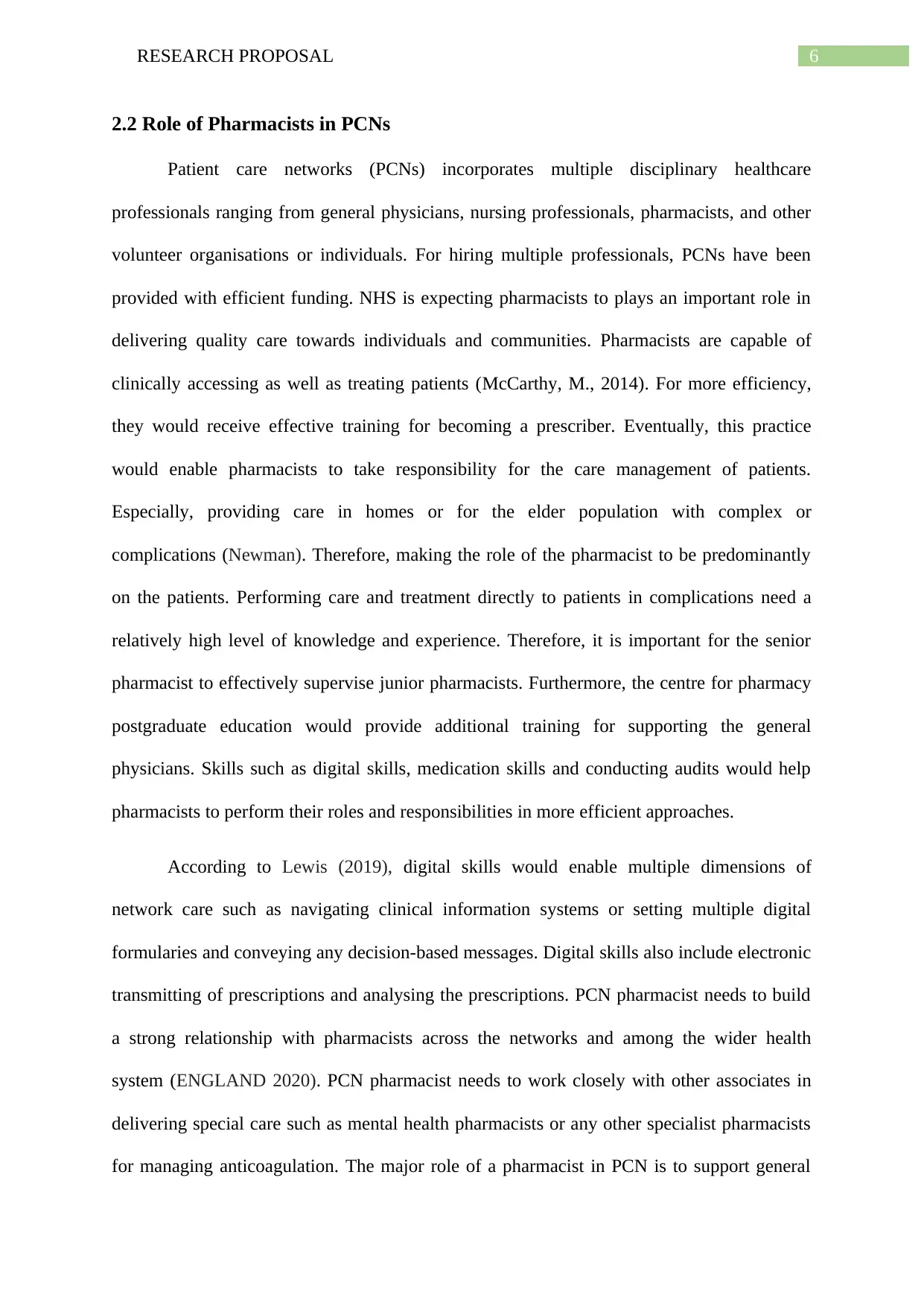
6RESEARCH PROPOSAL
2.2 Role of Pharmacists in PCNs
Patient care networks (PCNs) incorporates multiple disciplinary healthcare
professionals ranging from general physicians, nursing professionals, pharmacists, and other
volunteer organisations or individuals. For hiring multiple professionals, PCNs have been
provided with efficient funding. NHS is expecting pharmacists to plays an important role in
delivering quality care towards individuals and communities. Pharmacists are capable of
clinically accessing as well as treating patients (McCarthy, M., 2014). For more efficiency,
they would receive effective training for becoming a prescriber. Eventually, this practice
would enable pharmacists to take responsibility for the care management of patients.
Especially, providing care in homes or for the elder population with complex or
complications (Newman). Therefore, making the role of the pharmacist to be predominantly
on the patients. Performing care and treatment directly to patients in complications need a
relatively high level of knowledge and experience. Therefore, it is important for the senior
pharmacist to effectively supervise junior pharmacists. Furthermore, the centre for pharmacy
postgraduate education would provide additional training for supporting the general
physicians. Skills such as digital skills, medication skills and conducting audits would help
pharmacists to perform their roles and responsibilities in more efficient approaches.
According to Lewis (2019), digital skills would enable multiple dimensions of
network care such as navigating clinical information systems or setting multiple digital
formularies and conveying any decision-based messages. Digital skills also include electronic
transmitting of prescriptions and analysing the prescriptions. PCN pharmacist needs to build
a strong relationship with pharmacists across the networks and among the wider health
system (ENGLAND 2020). PCN pharmacist needs to work closely with other associates in
delivering special care such as mental health pharmacists or any other specialist pharmacists
for managing anticoagulation. The major role of a pharmacist in PCN is to support general
2.2 Role of Pharmacists in PCNs
Patient care networks (PCNs) incorporates multiple disciplinary healthcare
professionals ranging from general physicians, nursing professionals, pharmacists, and other
volunteer organisations or individuals. For hiring multiple professionals, PCNs have been
provided with efficient funding. NHS is expecting pharmacists to plays an important role in
delivering quality care towards individuals and communities. Pharmacists are capable of
clinically accessing as well as treating patients (McCarthy, M., 2014). For more efficiency,
they would receive effective training for becoming a prescriber. Eventually, this practice
would enable pharmacists to take responsibility for the care management of patients.
Especially, providing care in homes or for the elder population with complex or
complications (Newman). Therefore, making the role of the pharmacist to be predominantly
on the patients. Performing care and treatment directly to patients in complications need a
relatively high level of knowledge and experience. Therefore, it is important for the senior
pharmacist to effectively supervise junior pharmacists. Furthermore, the centre for pharmacy
postgraduate education would provide additional training for supporting the general
physicians. Skills such as digital skills, medication skills and conducting audits would help
pharmacists to perform their roles and responsibilities in more efficient approaches.
According to Lewis (2019), digital skills would enable multiple dimensions of
network care such as navigating clinical information systems or setting multiple digital
formularies and conveying any decision-based messages. Digital skills also include electronic
transmitting of prescriptions and analysing the prescriptions. PCN pharmacist needs to build
a strong relationship with pharmacists across the networks and among the wider health
system (ENGLAND 2020). PCN pharmacist needs to work closely with other associates in
delivering special care such as mental health pharmacists or any other specialist pharmacists
for managing anticoagulation. The major role of a pharmacist in PCN is to support general
Paraphrase This Document
Need a fresh take? Get an instant paraphrase of this document with our AI Paraphraser
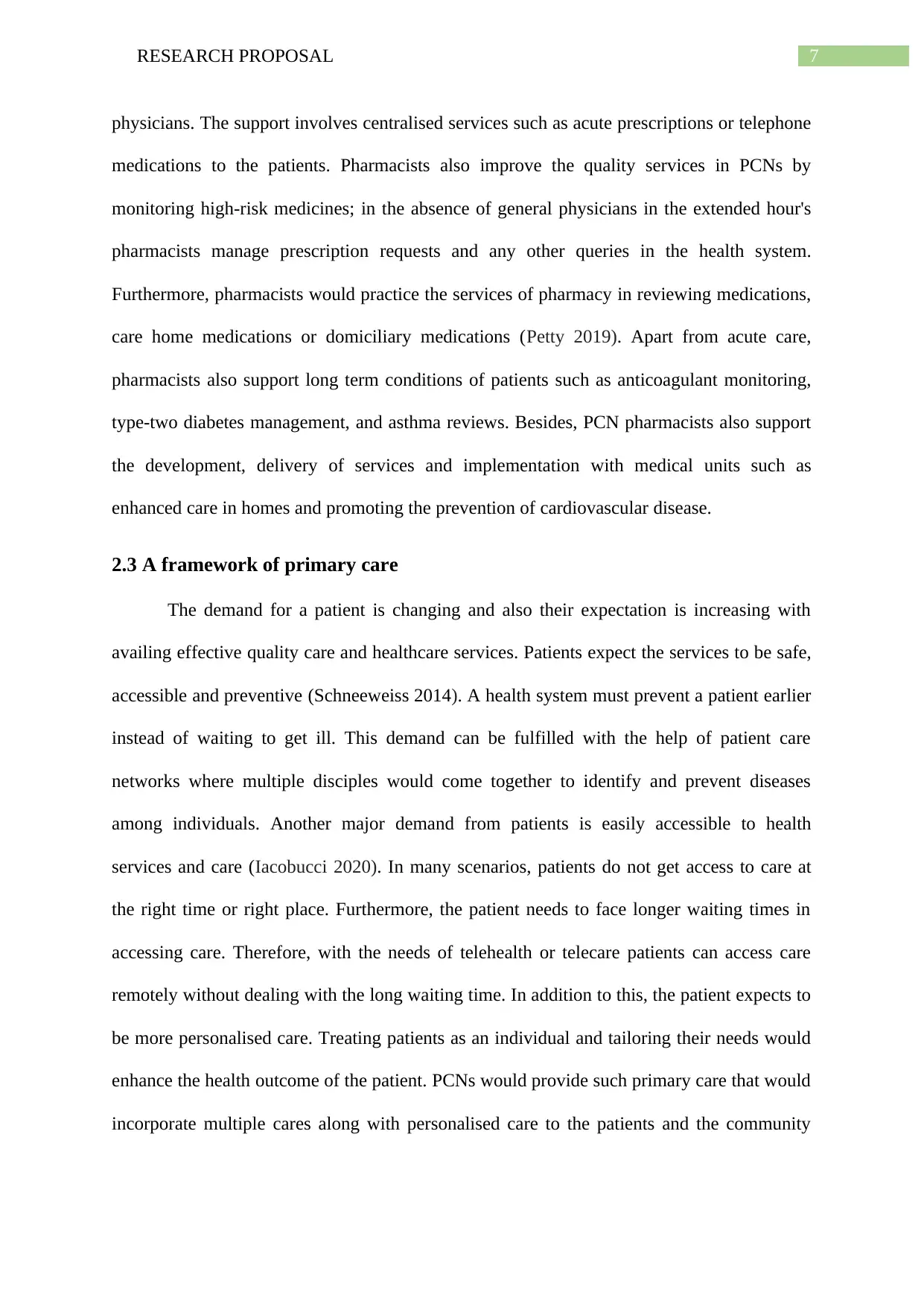
7RESEARCH PROPOSAL
physicians. The support involves centralised services such as acute prescriptions or telephone
medications to the patients. Pharmacists also improve the quality services in PCNs by
monitoring high-risk medicines; in the absence of general physicians in the extended hour's
pharmacists manage prescription requests and any other queries in the health system.
Furthermore, pharmacists would practice the services of pharmacy in reviewing medications,
care home medications or domiciliary medications (Petty 2019). Apart from acute care,
pharmacists also support long term conditions of patients such as anticoagulant monitoring,
type-two diabetes management, and asthma reviews. Besides, PCN pharmacists also support
the development, delivery of services and implementation with medical units such as
enhanced care in homes and promoting the prevention of cardiovascular disease.
2.3 A framework of primary care
The demand for a patient is changing and also their expectation is increasing with
availing effective quality care and healthcare services. Patients expect the services to be safe,
accessible and preventive (Schneeweiss 2014). A health system must prevent a patient earlier
instead of waiting to get ill. This demand can be fulfilled with the help of patient care
networks where multiple disciples would come together to identify and prevent diseases
among individuals. Another major demand from patients is easily accessible to health
services and care (Iacobucci 2020). In many scenarios, patients do not get access to care at
the right time or right place. Furthermore, the patient needs to face longer waiting times in
accessing care. Therefore, with the needs of telehealth or telecare patients can access care
remotely without dealing with the long waiting time. In addition to this, the patient expects to
be more personalised care. Treating patients as an individual and tailoring their needs would
enhance the health outcome of the patient. PCNs would provide such primary care that would
incorporate multiple cares along with personalised care to the patients and the community
physicians. The support involves centralised services such as acute prescriptions or telephone
medications to the patients. Pharmacists also improve the quality services in PCNs by
monitoring high-risk medicines; in the absence of general physicians in the extended hour's
pharmacists manage prescription requests and any other queries in the health system.
Furthermore, pharmacists would practice the services of pharmacy in reviewing medications,
care home medications or domiciliary medications (Petty 2019). Apart from acute care,
pharmacists also support long term conditions of patients such as anticoagulant monitoring,
type-two diabetes management, and asthma reviews. Besides, PCN pharmacists also support
the development, delivery of services and implementation with medical units such as
enhanced care in homes and promoting the prevention of cardiovascular disease.
2.3 A framework of primary care
The demand for a patient is changing and also their expectation is increasing with
availing effective quality care and healthcare services. Patients expect the services to be safe,
accessible and preventive (Schneeweiss 2014). A health system must prevent a patient earlier
instead of waiting to get ill. This demand can be fulfilled with the help of patient care
networks where multiple disciples would come together to identify and prevent diseases
among individuals. Another major demand from patients is easily accessible to health
services and care (Iacobucci 2020). In many scenarios, patients do not get access to care at
the right time or right place. Furthermore, the patient needs to face longer waiting times in
accessing care. Therefore, with the needs of telehealth or telecare patients can access care
remotely without dealing with the long waiting time. In addition to this, the patient expects to
be more personalised care. Treating patients as an individual and tailoring their needs would
enhance the health outcome of the patient. PCNs would provide such primary care that would
incorporate multiple cares along with personalised care to the patients and the community
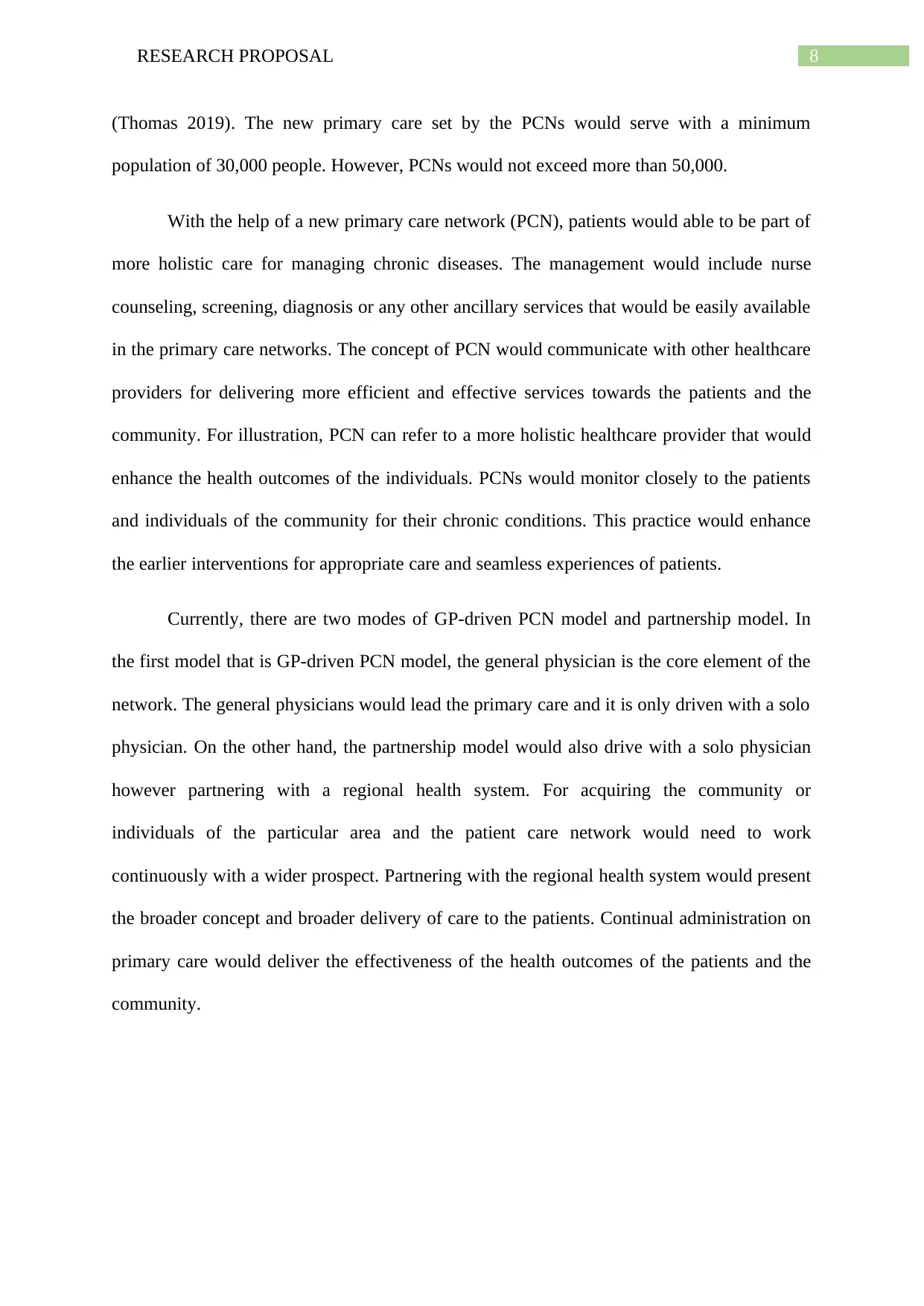
8RESEARCH PROPOSAL
(Thomas 2019). The new primary care set by the PCNs would serve with a minimum
population of 30,000 people. However, PCNs would not exceed more than 50,000.
With the help of a new primary care network (PCN), patients would able to be part of
more holistic care for managing chronic diseases. The management would include nurse
counseling, screening, diagnosis or any other ancillary services that would be easily available
in the primary care networks. The concept of PCN would communicate with other healthcare
providers for delivering more efficient and effective services towards the patients and the
community. For illustration, PCN can refer to a more holistic healthcare provider that would
enhance the health outcomes of the individuals. PCNs would monitor closely to the patients
and individuals of the community for their chronic conditions. This practice would enhance
the earlier interventions for appropriate care and seamless experiences of patients.
Currently, there are two modes of GP-driven PCN model and partnership model. In
the first model that is GP-driven PCN model, the general physician is the core element of the
network. The general physicians would lead the primary care and it is only driven with a solo
physician. On the other hand, the partnership model would also drive with a solo physician
however partnering with a regional health system. For acquiring the community or
individuals of the particular area and the patient care network would need to work
continuously with a wider prospect. Partnering with the regional health system would present
the broader concept and broader delivery of care to the patients. Continual administration on
primary care would deliver the effectiveness of the health outcomes of the patients and the
community.
(Thomas 2019). The new primary care set by the PCNs would serve with a minimum
population of 30,000 people. However, PCNs would not exceed more than 50,000.
With the help of a new primary care network (PCN), patients would able to be part of
more holistic care for managing chronic diseases. The management would include nurse
counseling, screening, diagnosis or any other ancillary services that would be easily available
in the primary care networks. The concept of PCN would communicate with other healthcare
providers for delivering more efficient and effective services towards the patients and the
community. For illustration, PCN can refer to a more holistic healthcare provider that would
enhance the health outcomes of the individuals. PCNs would monitor closely to the patients
and individuals of the community for their chronic conditions. This practice would enhance
the earlier interventions for appropriate care and seamless experiences of patients.
Currently, there are two modes of GP-driven PCN model and partnership model. In
the first model that is GP-driven PCN model, the general physician is the core element of the
network. The general physicians would lead the primary care and it is only driven with a solo
physician. On the other hand, the partnership model would also drive with a solo physician
however partnering with a regional health system. For acquiring the community or
individuals of the particular area and the patient care network would need to work
continuously with a wider prospect. Partnering with the regional health system would present
the broader concept and broader delivery of care to the patients. Continual administration on
primary care would deliver the effectiveness of the health outcomes of the patients and the
community.
⊘ This is a preview!⊘
Do you want full access?
Subscribe today to unlock all pages.

Trusted by 1+ million students worldwide
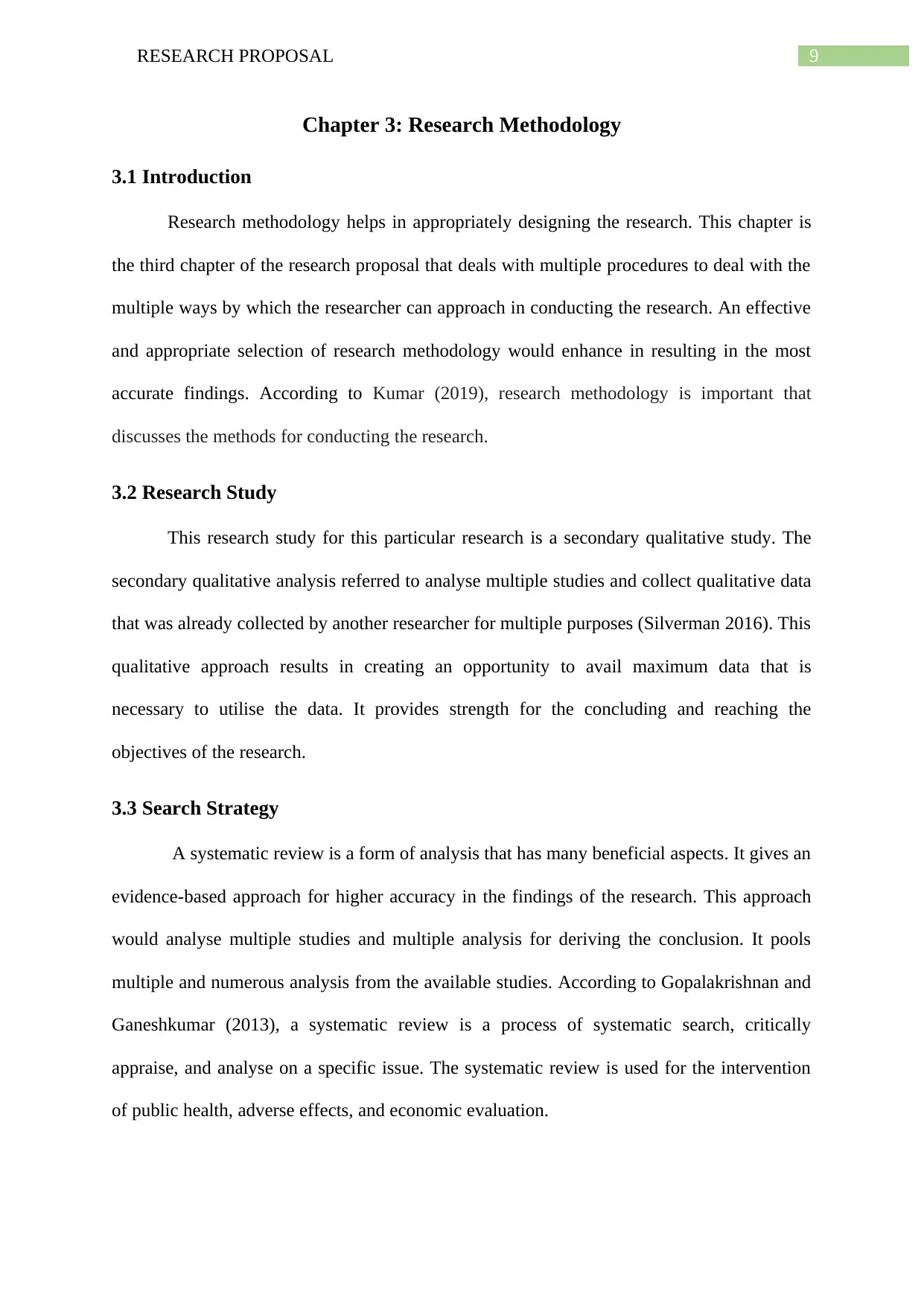
9RESEARCH PROPOSAL
Chapter 3: Research Methodology
3.1 Introduction
Research methodology helps in appropriately designing the research. This chapter is
the third chapter of the research proposal that deals with multiple procedures to deal with the
multiple ways by which the researcher can approach in conducting the research. An effective
and appropriate selection of research methodology would enhance in resulting in the most
accurate findings. According to Kumar (2019), research methodology is important that
discusses the methods for conducting the research.
3.2 Research Study
This research study for this particular research is a secondary qualitative study. The
secondary qualitative analysis referred to analyse multiple studies and collect qualitative data
that was already collected by another researcher for multiple purposes (Silverman 2016). This
qualitative approach results in creating an opportunity to avail maximum data that is
necessary to utilise the data. It provides strength for the concluding and reaching the
objectives of the research.
3.3 Search Strategy
A systematic review is a form of analysis that has many beneficial aspects. It gives an
evidence-based approach for higher accuracy in the findings of the research. This approach
would analyse multiple studies and multiple analysis for deriving the conclusion. It pools
multiple and numerous analysis from the available studies. According to Gopalakrishnan and
Ganeshkumar (2013), a systematic review is a process of systematic search, critically
appraise, and analyse on a specific issue. The systematic review is used for the intervention
of public health, adverse effects, and economic evaluation.
Chapter 3: Research Methodology
3.1 Introduction
Research methodology helps in appropriately designing the research. This chapter is
the third chapter of the research proposal that deals with multiple procedures to deal with the
multiple ways by which the researcher can approach in conducting the research. An effective
and appropriate selection of research methodology would enhance in resulting in the most
accurate findings. According to Kumar (2019), research methodology is important that
discusses the methods for conducting the research.
3.2 Research Study
This research study for this particular research is a secondary qualitative study. The
secondary qualitative analysis referred to analyse multiple studies and collect qualitative data
that was already collected by another researcher for multiple purposes (Silverman 2016). This
qualitative approach results in creating an opportunity to avail maximum data that is
necessary to utilise the data. It provides strength for the concluding and reaching the
objectives of the research.
3.3 Search Strategy
A systematic review is a form of analysis that has many beneficial aspects. It gives an
evidence-based approach for higher accuracy in the findings of the research. This approach
would analyse multiple studies and multiple analysis for deriving the conclusion. It pools
multiple and numerous analysis from the available studies. According to Gopalakrishnan and
Ganeshkumar (2013), a systematic review is a process of systematic search, critically
appraise, and analyse on a specific issue. The systematic review is used for the intervention
of public health, adverse effects, and economic evaluation.
Paraphrase This Document
Need a fresh take? Get an instant paraphrase of this document with our AI Paraphraser
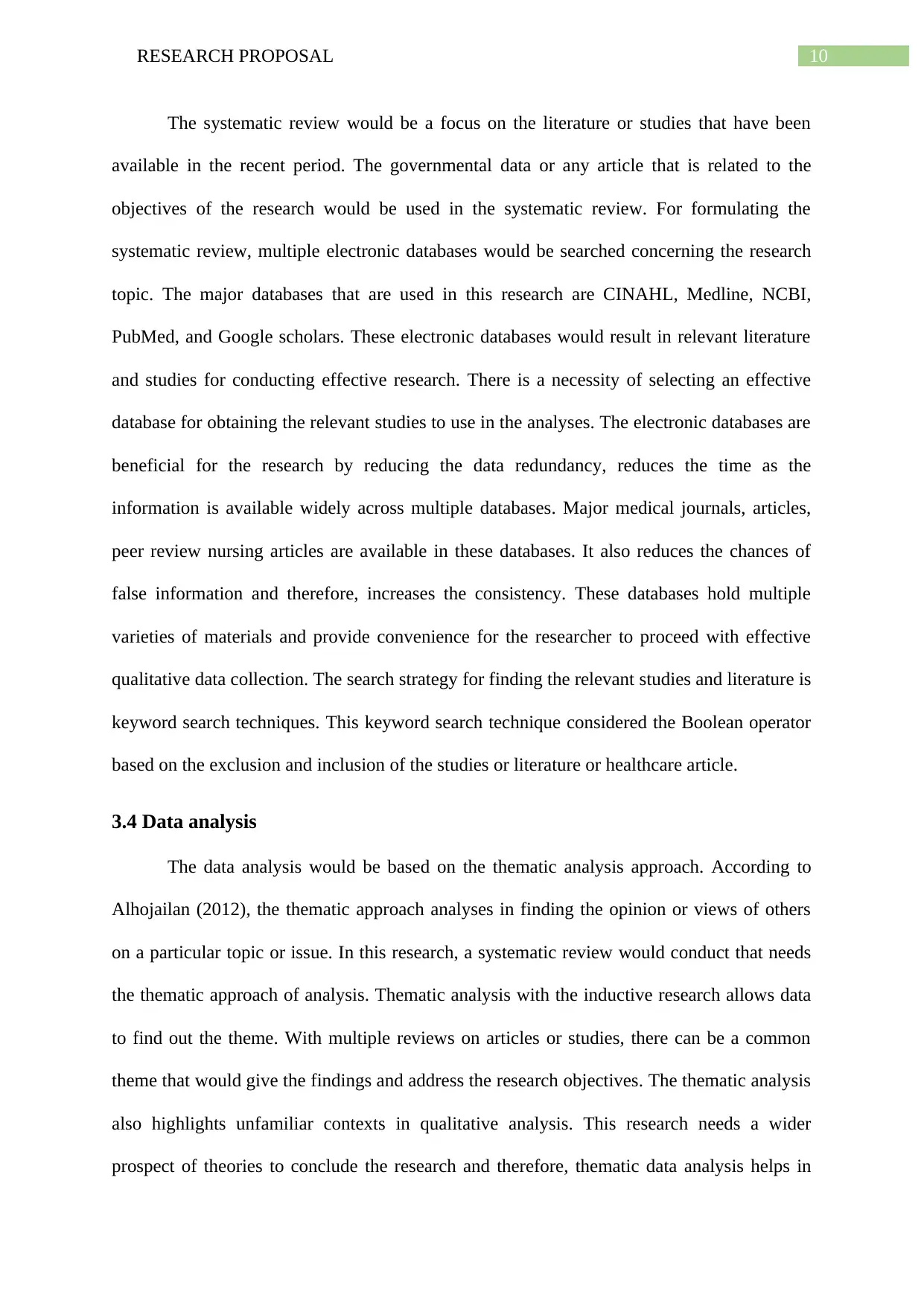
10RESEARCH PROPOSAL
The systematic review would be a focus on the literature or studies that have been
available in the recent period. The governmental data or any article that is related to the
objectives of the research would be used in the systematic review. For formulating the
systematic review, multiple electronic databases would be searched concerning the research
topic. The major databases that are used in this research are CINAHL, Medline, NCBI,
PubMed, and Google scholars. These electronic databases would result in relevant literature
and studies for conducting effective research. There is a necessity of selecting an effective
database for obtaining the relevant studies to use in the analyses. The electronic databases are
beneficial for the research by reducing the data redundancy, reduces the time as the
information is available widely across multiple databases. Major medical journals, articles,
peer review nursing articles are available in these databases. It also reduces the chances of
false information and therefore, increases the consistency. These databases hold multiple
varieties of materials and provide convenience for the researcher to proceed with effective
qualitative data collection. The search strategy for finding the relevant studies and literature is
keyword search techniques. This keyword search technique considered the Boolean operator
based on the exclusion and inclusion of the studies or literature or healthcare article.
3.4 Data analysis
The data analysis would be based on the thematic analysis approach. According to
Alhojailan (2012), the thematic approach analyses in finding the opinion or views of others
on a particular topic or issue. In this research, a systematic review would conduct that needs
the thematic approach of analysis. Thematic analysis with the inductive research allows data
to find out the theme. With multiple reviews on articles or studies, there can be a common
theme that would give the findings and address the research objectives. The thematic analysis
also highlights unfamiliar contexts in qualitative analysis. This research needs a wider
prospect of theories to conclude the research and therefore, thematic data analysis helps in
The systematic review would be a focus on the literature or studies that have been
available in the recent period. The governmental data or any article that is related to the
objectives of the research would be used in the systematic review. For formulating the
systematic review, multiple electronic databases would be searched concerning the research
topic. The major databases that are used in this research are CINAHL, Medline, NCBI,
PubMed, and Google scholars. These electronic databases would result in relevant literature
and studies for conducting effective research. There is a necessity of selecting an effective
database for obtaining the relevant studies to use in the analyses. The electronic databases are
beneficial for the research by reducing the data redundancy, reduces the time as the
information is available widely across multiple databases. Major medical journals, articles,
peer review nursing articles are available in these databases. It also reduces the chances of
false information and therefore, increases the consistency. These databases hold multiple
varieties of materials and provide convenience for the researcher to proceed with effective
qualitative data collection. The search strategy for finding the relevant studies and literature is
keyword search techniques. This keyword search technique considered the Boolean operator
based on the exclusion and inclusion of the studies or literature or healthcare article.
3.4 Data analysis
The data analysis would be based on the thematic analysis approach. According to
Alhojailan (2012), the thematic approach analyses in finding the opinion or views of others
on a particular topic or issue. In this research, a systematic review would conduct that needs
the thematic approach of analysis. Thematic analysis with the inductive research allows data
to find out the theme. With multiple reviews on articles or studies, there can be a common
theme that would give the findings and address the research objectives. The thematic analysis
also highlights unfamiliar contexts in qualitative analysis. This research needs a wider
prospect of theories to conclude the research and therefore, thematic data analysis helps in
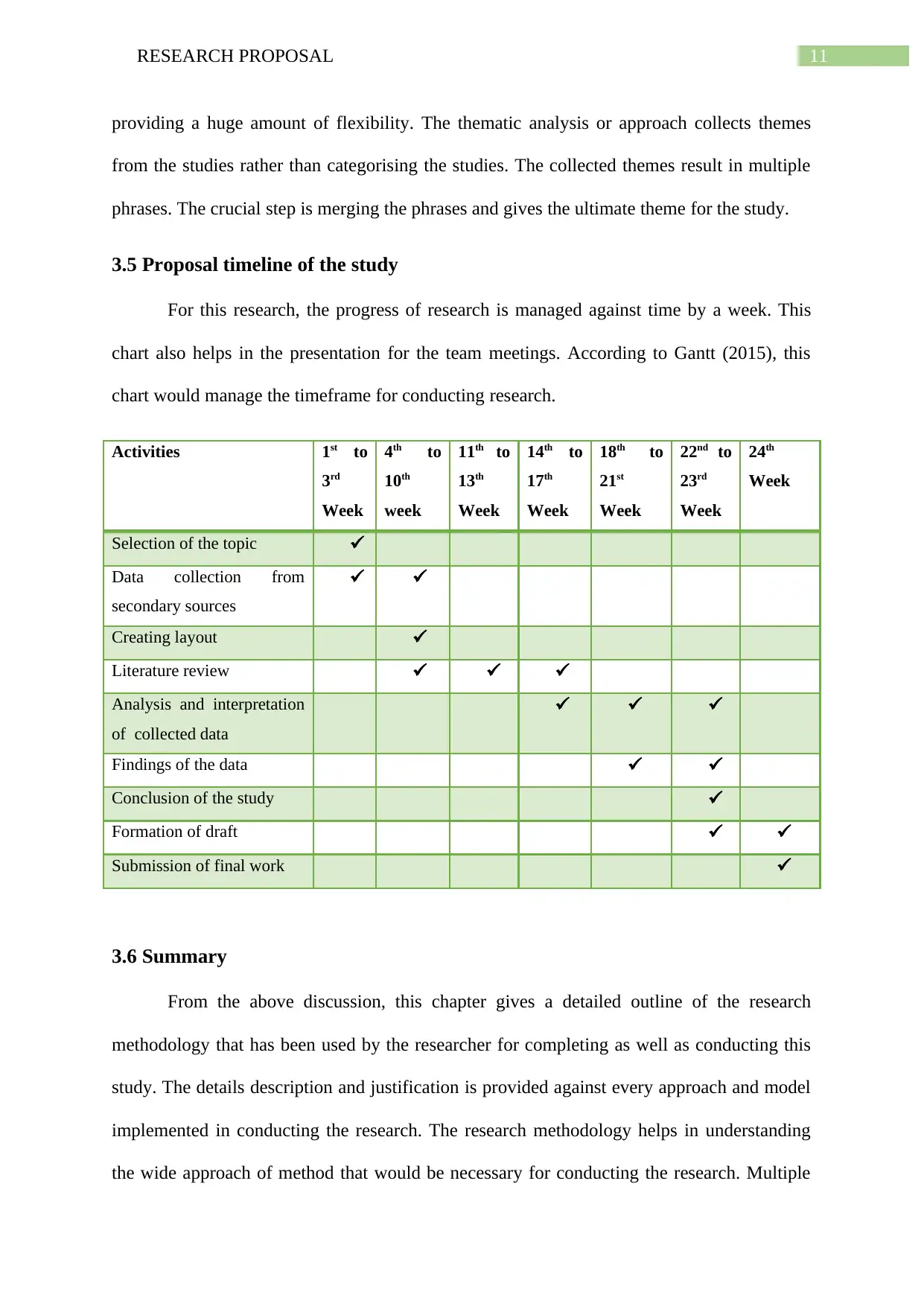
11RESEARCH PROPOSAL
providing a huge amount of flexibility. The thematic analysis or approach collects themes
from the studies rather than categorising the studies. The collected themes result in multiple
phrases. The crucial step is merging the phrases and gives the ultimate theme for the study.
3.5 Proposal timeline of the study
For this research, the progress of research is managed against time by a week. This
chart also helps in the presentation for the team meetings. According to Gantt (2015), this
chart would manage the timeframe for conducting research.
Activities 1st to
3rd
Week
4th to
10th
week
11th to
13th
Week
14th to
17th
Week
18th to
21st
Week
22nd to
23rd
Week
24th
Week
Selection of the topic
Data collection from
secondary sources
Creating layout
Literature review
Analysis and interpretation
of collected data
Findings of the data
Conclusion of the study
Formation of draft
Submission of final work
3.6 Summary
From the above discussion, this chapter gives a detailed outline of the research
methodology that has been used by the researcher for completing as well as conducting this
study. The details description and justification is provided against every approach and model
implemented in conducting the research. The research methodology helps in understanding
the wide approach of method that would be necessary for conducting the research. Multiple
providing a huge amount of flexibility. The thematic analysis or approach collects themes
from the studies rather than categorising the studies. The collected themes result in multiple
phrases. The crucial step is merging the phrases and gives the ultimate theme for the study.
3.5 Proposal timeline of the study
For this research, the progress of research is managed against time by a week. This
chart also helps in the presentation for the team meetings. According to Gantt (2015), this
chart would manage the timeframe for conducting research.
Activities 1st to
3rd
Week
4th to
10th
week
11th to
13th
Week
14th to
17th
Week
18th to
21st
Week
22nd to
23rd
Week
24th
Week
Selection of the topic
Data collection from
secondary sources
Creating layout
Literature review
Analysis and interpretation
of collected data
Findings of the data
Conclusion of the study
Formation of draft
Submission of final work
3.6 Summary
From the above discussion, this chapter gives a detailed outline of the research
methodology that has been used by the researcher for completing as well as conducting this
study. The details description and justification is provided against every approach and model
implemented in conducting the research. The research methodology helps in understanding
the wide approach of method that would be necessary for conducting the research. Multiple
⊘ This is a preview!⊘
Do you want full access?
Subscribe today to unlock all pages.

Trusted by 1+ million students worldwide
1 out of 15
Related Documents
Your All-in-One AI-Powered Toolkit for Academic Success.
+13062052269
info@desklib.com
Available 24*7 on WhatsApp / Email
![[object Object]](/_next/static/media/star-bottom.7253800d.svg)
Unlock your academic potential
Copyright © 2020–2025 A2Z Services. All Rights Reserved. Developed and managed by ZUCOL.





